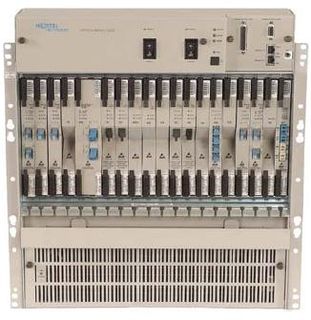Multiprotocol Label Switching (MPLS) is a routing technique in telecommunications networks that directs data from one node to the next based on labels rather than network addresses. Whereas network addresses identify endpoints the labels identify established paths between endpoints. MPLS can encapsulate packets of various network protocols, hence the multiprotocol component of the name. MPLS supports a range of access technologies, including T1/E1, ATM, Frame Relay, and DSL.

Frame Relay is a standardized wide area network (WAN) technology that specifies the physical and data link layers of digital telecommunications channels using a packet switching methodology. Originally designed for transport across Integrated Services Digital Network (ISDN) infrastructure, it may be used today in the context of many other network interfaces.
In the IEEE 802 reference model of computer networking, the logical link control (LLC) data communication protocol layer is the upper sublayer of the data link layer of the seven-layer OSI model. The LLC sublayer acts as an interface between the media access control (MAC) sublayer and the network layer.
A virtual private network (VPN) extends a private network across a public network and enables users to send and receive data across shared or public networks as if their computing devices were directly connected to the private network. The benefits of a VPN include increases in functionality, security, and management of the private network. It provides access to resources that are inaccessible on the public network and is typically used for remote workers. Encryption is common, although not an inherent part of a VPN connection.
Resilient Packet Ring (RPR), as defined by IEEE standard 802.17, is a protocol designed for the transport of data traffic over optical fiber ring networks. The standard began development in November 2000 and has undergone several amendments since its initial standard was completed in June 2004. The amended standards are 802.17a through 802.17d, the last of which was adopted in May 2011. It is designed to provide the resilience found in SONET and Synchronous Digital Hierarchy networks but, instead of setting up circuit oriented connections, provides a packet based transmission, in order to increase the efficiency of Ethernet and IP services.
Virtual Private LAN Service (VPLS) is a way to provide Ethernet-based multipoint to multipoint communication over IP or MPLS networks. It allows geographically dispersed sites to share an Ethernet broadcast domain by connecting sites through pseudowires. The term sites includes multiplicities of both servers and clients. The technologies that can be used as pseudo-wire can be Ethernet over MPLS, L2TPv3 or even GRE. There are two IETF standards track RFCs describing VPLS establishment.
The next-generation network (NGN) is a body of key architectural changes in telecommunication core and access networks. The general idea behind the NGN is that one network transports all information and services by encapsulating these into IP packets, similar to those used on the Internet. NGNs are commonly built around the Internet Protocol, and therefore the term all IP is also sometimes used to describe the transformation of formerly telephone-centric networks toward NGN.

A metropolitan-area Ethernet, Ethernet MAN, or metro Ethernet network is a metropolitan area network (MAN) that is based on Ethernet standards. It is commonly used to connect subscribers to a larger service network or the Internet. Businesses can also use metropolitan-area Ethernet to connect their own offices to each other.

A computer network is a set of computers sharing resources located on or provided by network nodes. The computers use common communication protocols over digital interconnections to communicate with each other. These interconnections are made up of telecommunication network technologies, based on physically wired, optical, and wireless radio-frequency methods that may be arranged in a variety of network topologies.
Ethernet in the first mile (EFM) refers to using one of the Ethernet family of computer network technologies between a telecommunications company and a customer's premises. From the customer's point of view, it is their first mile, although from the access network's point of view it is known as the last mile.
Operations, administration and management or operations, administration and maintenance are the processes, activities, tools, and standards involved with operating, administering, managing and maintaining any system. This commonly applies to telecommunication, computer networks, and computer hardware.
Provider Backbone Bridge Traffic Engineering (PBB-TE) is an approved telecommunications networking standard, IEEE 802.1Qay-2009. PBB-TE adapts Ethernet technology to carrier class transport networks. It is based on the layered VLAN tags and MAC-in-MAC encapsulation defined in IEEE 802.1ah, but it differs from PBB in eliminating flooding, dynamically created forwarding tables, and spanning tree protocols. Compared to PBB and its predecessors, PBB-TE behaves more predictably and its behavior can be more easily controlled by the network operator, at the expense of requiring up-front connection configuration at each bridge along a forwarding path. PBB-TE Operations, Administration, and Management (OAM) is usually based on IEEE 802.1ag. It was initially based on Nortel's Provider Backbone Transport (PBT).
Provider Backbone Bridges is a set of architecture and protocols for routing over a provider's network allowing interconnection of multiple provider bridge networks without losing each customer's individually defined VLANs. It was initially created by Nortel before being submitted to the IEEE 802.1 committee for standardization. The final standard was approved by the IEEE in June 2008 as IEEE 802.1ah-2008 and has been integrated into IEEE 802.1Q-2011.
T-MPLS or Transport MPLS is a transport network layer technology that uses extensions to a subset of the existing MPLS standards and is designed specifically for application in transport networks. Work to define T-MPLS was started by the ITU-T in February 2006. It was intended specifically as a connection-oriented packet-switched (co-ps) application offering a simpler implementation by removing MPLS features that are not relevant to co-ps applications and adding mechanisms that provide support of critical transport functionality.

Metro Ethernet Routing Switch 8600 or MERS 8600 is a modular chassis router and/or switch manufactured by Nortel now acquired by Ciena. The MERS 8600 supports the Provider Backbone Bridges (PBB), Provider Backbone Transport (PBT) technologies and carrier class Operations Administration & Maintenance (OAM) tools.
Hierarchical VLAN (HVLAN) is a proposed Ethernet standard that extends the use of enterprise Ethernet VLAN (802.1Q) to carrier networks. A number of developments have emerged in recent years to help bring Ethernet, a flexible and cost-efficient packet transport technology, to carrier networks. These developments include Q-in-Q (802.1ad), PBB (802.1ah), PBT, and PBB-TE, which bring a set of features to traditional Ethernet to make it “carrier-grade”, adding to it high-availability, OA&M, and more.
Carrier Ethernet is a marketing term for extensions to Ethernet for communications service providers that utilize Ethernet technology in their networks.
In telecommunications, Multiprotocol Label Switching - Transport Profile (MPLS-TP) is a variant of the MPLS protocol that is used in packet switched data networks. MPLS-TP is the product of a joint Internet Engineering Task Force (IETF) / International Telecommunication Union Telecommunication Standardization Sector (ITU-T) effort to include an MPLS Transport Profile within the IETF MPLS and PWE3 architectures to support the capabilities and functionalities of a packet transport network.
Shortest Path Bridging (SPB), specified in the IEEE 802.1aq standard, is a computer networking technology intended to simplify the creation and configuration of networks, while enabling multipath routing.



